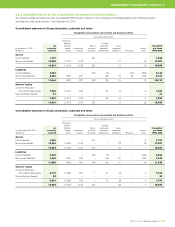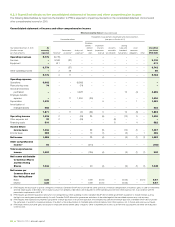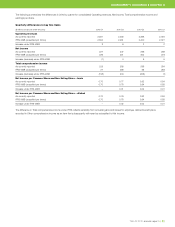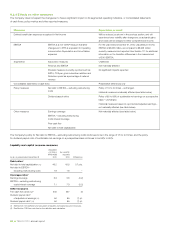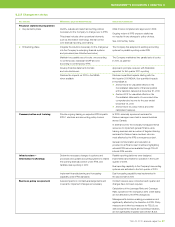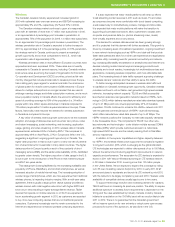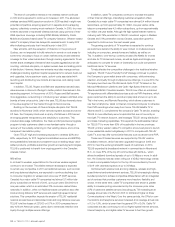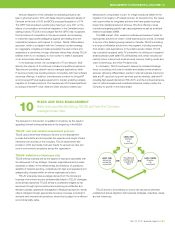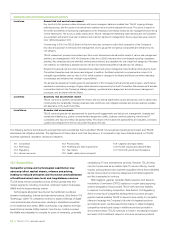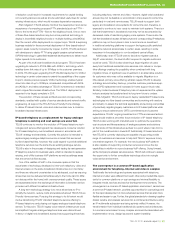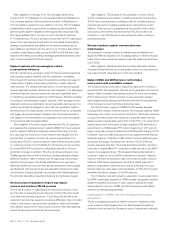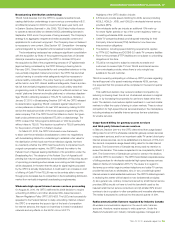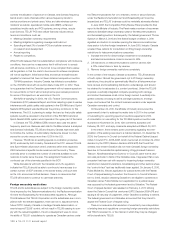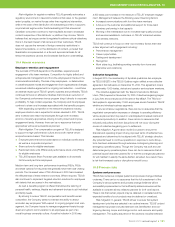Telus 2010 Annual Report Download - page 97
Download and view the complete annual report
Please find page 97 of the 2010 Telus annual report below. You can navigate through the pages in the report by either clicking on the pages listed below, or by using the keyword search tool below to find specific information within the annual report.
TELUS 2010 annual report . 93
MANAGEMENT’S DISCUSSION & ANALYSIS: 10
extend the Company’s footprint in healthcare, benefit from the investments
being made by governments in eHealth, bring to market services targeted
at consumers such as personal health records and tools to manage
their health, pursue the transformation of the Canadian pharmacy benefit
management sector and cross-sell more traditional telecom products
and services to the healthcare sector. TELUS is also focused on imple-
menting large enterprise deals that leverage the Company’s capital
investments and capabilities.
Wireline voice and data – Consumer
In the consumer wireline market, cable-TV companies and other
competitors encounter minimal regulation and continue to combine a
mix of residential local VoIP, long distance, HSIA and, in some cases,
wireless services into one bundled and/or discounted monthly rate,
along with their traditional broadcast or satellite-based TV services.
In addition, cable-TV companies continue to increase the speed of their
HSIA offerings. To a lesser extent, other non-facilities-based competi-
tors offer local and long distance VoIP services over the Internet and
resell HSIA solutions. Erosion of TELUS’ residential network access lines
(NALs) is expected to continue from this competition, as well as ongoing
technological and wireless substitution. Competitors are anticipated
to capture a majority of the share in growth marketplace opportunities;
therefore, access line associated revenues, including long distance,
can be expected to continue to decline. Although the HSIA market is
maturing, subscriber growth is expected to continue over the next several
years. With a more mature HSIA market, and the potential for higher-
speed Internet offerings from competitors, TELUS may be constrained
in its ability to maintain market share in its incumbent territories,
because of the amount and timing of capital expenditures associated
with maintaining competitive network access speeds.
Risk mitigation in the consumer wireline market: TELUS continues
to expand the coverage and increase the speed of its high-speed
Internet service and increase the coverage and capability of its IP-based
Optik TV service in its incumbent territories (see Broadcasting below
and Section 2.2 Strategic imperatives). The provision of Optik TV service
helps the Company attract pull-through Internet subscriptions and
generally counter cable-TV competition in its incumbent markets, and to
retain and grow revenues with a bundled offering of local and long dis-
tance telephony, HSIA and TV entertainment services. TELUS Satellite TV
service in Alberta and B.C. complements IP TV service, enabling the
Company to more effectively serve those households that are not currently
on the TELUS IP TV network footprint and leverage TELUS’ strong
distribution and marketing presence. TELUS Satellite TV service is made
possible by an agreement with Bell Canada.
Broadcasting
As noted above, the Company offers TELUS TV in B.C., Alberta and
Eastern Quebec, and continues targeted roll-outs of Optik TV to new
areas. While TELUS TV provides numerous interactivity and custom-
ization advantages, there can be no assurance that TELUS TV will be
successful in achieving its plans of obtaining a sizable share of the
TV services market or that implementation costs or projected revenues
for TELUS’ television service will be as planned.
Risk mitigation: Fully digital TELUS TV is offered as both an IP-based
service (in urban markets of B.C., Alberta and Eastern Quebec) and
as a satellite-based service (in B.C. and Alberta). TELUS broadened the
addressable market for its HD TV services through the deployment of
ADSL2+ technology and the Company continues to upgrade to VDSL2
technology. In February 2010, TELUS launched an upgrade of its IP TV
middleware to next generation Microsoft Mediaroom. These developments
and services, and enhance services with integrated bundle offers.
TELUS continues to expand into and generate growth in non-incumbent
markets in Central Canada with business services and mobility offerings.
TELUS also continues to actively pursue a competitive cost structure.
Customer experience
There is a risk that TELUS will not maintain or increase levels of client
loyalty if the products, services and service experience offered by the
Company do not meet or exceed customer expectations. If TELUS does
not provide a better customer experience than its competitors, the TELUS
brand image could suffer, and business clients and consumers may
change service providers. The Company’s profitability could be negatively
impacted should the costs to acquire and retain customers increase.
Risk mitigation: Enhancing customer experience and earning the
loyalty of clients is a prioritized Company-wide commitment, which was
accelerated in a major organization-wide initiative that commenced in
2010 and continues into 2011. Delivering on TELUS’ future friendly brand
promise to clients continues as one of the Company’s key corporate
priorities in 2011. (See Section 3.)
Wireline voice and data
Competition is expected to remain intense from traditional telephony, data,
IP and IT service providers, as well as from voice over Internet protocol
(VoIP) focused entrants in both business and consumer markets.
The industry transition from legacy voice infrastructure to IP telephony,
and from legacy data platforms to Ethernet, IP virtual private networks
(VPN), multi-protocol label switching (MPLS) IP platforms and IP-based
service delivery models, continues at a robust pace. Legacy data revenues
and margins continue to decline. This decline has been only partially
offset by increased demand and/or migration of customers to IP-based
platforms. IP-based solutions are also subject to downward pricing
pressure, lower margins and technological evolution. Capital investments
in wireline infrastructure are required to facilitate this ongoing transition
process for all traditional incumbent local exchange carrier (ILEC) entities
including TELUS.
Wireline voice and data – Business
In the business market, price-discounted bundling of local access,
wireless and advanced data and IP services has evolved to include
web-based and e-commerce services, as well as other IT services and
support. Non-traditional competitors such as Microsoft have entered
the telecom space through new products like Unified Communications,
which provides the ability to redirect and deliver, in real time, email,
voice and text messages from a variety of telecom and IT systems to
the device nearest to the intended recipient. With this broader bundling
of traditional telecom services with IT services, TELUS increasingly
faces competition from pure Internet and information technology hardware,
software and business process/consulting related companies. Cable-TV
companies target the SMB market with their VoIP services. The result
is that traditional and non-traditional competitors are now focused on
providing a broad range of telecommunications services to the business
market, particularly in the major urban areas.
Risk mitigation in the business wireline market: TELUS continues
to increase its capabilities through a combination of strategic acquisitions
and partnerships, a focus on priority vertical markets (public sector,
healthcare, financial services, energy, and telecom wholesale), expansion
of strategic solution sets in the enterprise market, and a mass modular
approach in the SMB market (including services such as TELUS Business
One). Since the launch of TELUS Health Solutions in 2008, TELUS now
leverages systems, its proprietary solutions and its reach and brand to


